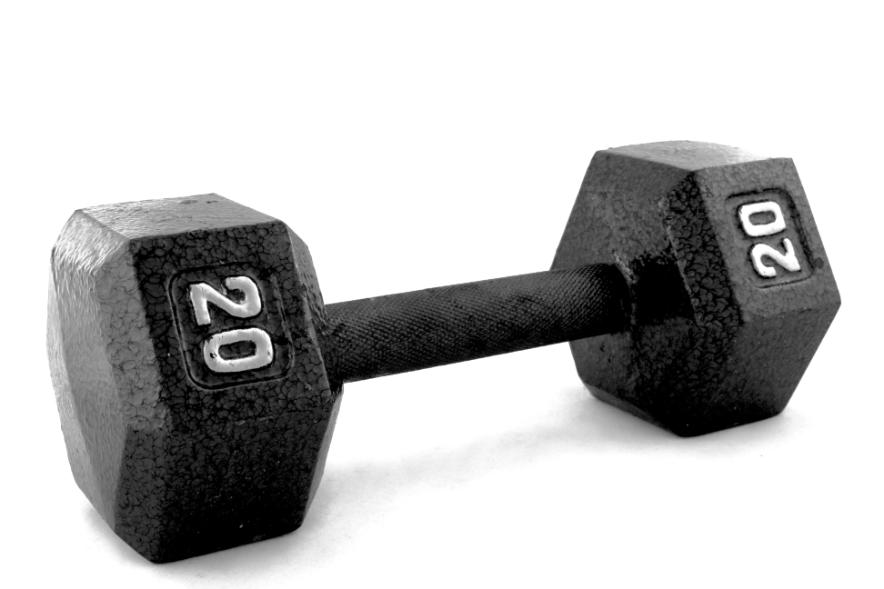
Why a dumbbell is called a dumbbell? There is actually a connection with this term and church bells! Since it took a fair amount of strength to ring a heavy church bell properly, novice ringers had to develop their arm strength with a rope connected to a metal weight. Swinging the weighted rope against an imaginary bell produced no sound, thus it was silent or dumb. Eventually, the apparatus came to be known as a dumbbell. By the 16th century, it was fashionable for gentlemen to do “bell” work to develop an impressive physique. In the 1800’s, the short bar replaced the rope and rounded weights were attached at both ends. The same fitness history aficionados believe that “silent” church bells without clappers were used as weights at both ends of a bar. In today’s society the dumbbell is still used to enhance ones physique.
The dumbbell can range anywhere from two pounds to upwards of one hundred and fifty pounds! Adjustable dumbbells are also can be used. Most gyms have a set location in the building where all the weights are located; generally these spaces are accompanied with a mirror so one can check their form. Dumbbell can be used alone, with a bench (inclined, flat or declined) or with another piece of equipment to make the exercise more challenging. Selecting the proper weight for ones lifts should be determined by the goals they have in mind. If one is going for tone they should pick a weight they can complete 15-20 reps, if going for size 10-12 times and strength 3- 6 times. Typically 2-4 sets are appropriate. The benefits of dumbbells exercises compared to machines are: the joints can move freely in a multi dimensional plane which creates more of a challenge, allows stabilizer muscles to activate strengthening the joint, affordability and exercise variety. A good full body dumbbell workout will cover all major muscle groups as well as some secondary muscles.
Here is a breakdown of a full body dumbbell workout that one could do 2-3 times a week for a period of 1-2 months.
Bench Press
- Lie down on your back on a bench and hold 2 dumbbells at chest level along your body, palms facing your feet.
- Raise the dumbbells straight up until your elbows are close to being locked and lower them back slowly after a short pause.
- Breathe out when raising the dumbbells and breathe in when lowering them back.
- Stand up and reach down in order to hold two dumbbells with both hands (knees slightly bent).
- Lift the dumbbells up until your upper arms are parallel to your body and lower them back after a short pause.
- Try to keep your back straight throughout. Only the arm should move.
- Stand up and reach down in order to hold two dumbbells with both hands (knees slightly bent).
- Raise your upper body until you are standing and lower it back after a short pause.
- Try to keep your arms straight throughout by keeping the same small arch in your elbows.
Squat
- Stand up and hold one dumbbell with both hands in front of your thighs.
- Lower your body by bending your knees until they form a 90 degree angle and raise yourself back up after a short pause.
- Keep your upper body steady throughout.
Reverse Lunge
- Stand up and hold one dumbbell on each hand along the sides of your body, palms facing your body.
- Place a foot back and bend your knees in order to bring down your body until your knees form 90 degree angles and raise yourself back up after a short pause.
- Keep your upper body steady throughout
- Stand up and hold two dumbbells close to your shoulders, palms facing forward.
- Raise the dumbbells straight up until your elbows come close to locking and lower them back after a short pause.
- Be careful NOT to jerk your back in an effort to help you raise the dumbbells.
- Stand up and hold one dumbbell with each hand in front of your hips, palms facing each other.
- Raise the dumbbells to your sides until your arms are close to being parallel to the ground and lower them back down after a short pause.
- Try to maintain the angles in your elbows still throughout.
- Stand up and hold one dumbbell with each hand down the side of your body, palms facing forward.
- Raise both dumbbells until they reach your shoulders' height and slowly lower them back down after a short pause.
- Try NOT to jerk your upper body—as you bring your arms up—in an effort to help you lift the weights.
Overhead Triceps Extension
- Stand up and hold one dumbbell with both hands behind your head, upper arms pointing straight up.
- Raise the dumbbell up by extending your elbows and slowly lower it back after a short pause.
- Your upper arms should remain still throughout.